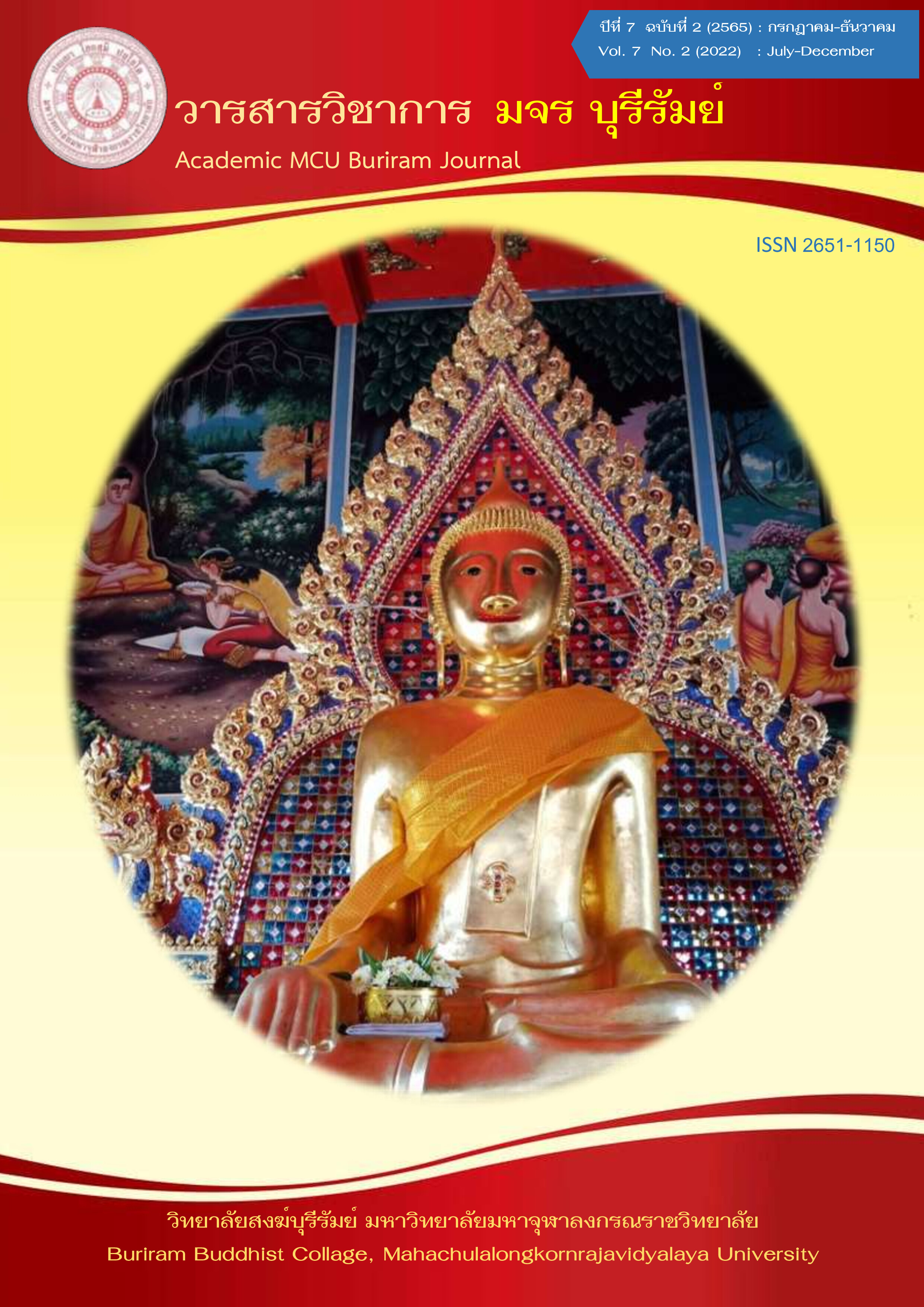Ontology Values of One-Night Among Modern Adolescents in Buriram Province
Keywords:
Ontology, Values, One-Night Stand, Modern AdolescentsAbstract
The objectives of this research were to 1) study the values of one-night partner relationship among modern adolescents in Buriram Province; 2) investigate the impact of one-night stand values among teenagers in the new era in Buriram Province. The researcher collected the data through in-depth interview, group discussion, field study, and related literatures and researches.
The results of the study revealed that:
The one-night-stand was based on 4 reasons as follows: 1) family upbringing, 2) friends, 3) entertainment, and 4) technology. As for the impact of the one-night partner relationship values, it was found that there were three aspects: first, the self-effect, which was unprepared pregnancy, abortion, and academic performance problems; secondly, the family impact was divorce, parenting problems, and abandoned baby; and the third social impacts include sexually transmitted diseases, violence problem, and physical abuse problem. Therefore, the new era adolescent values ontology must put the appropriate measures to the current events, as well as to find three preventive and corrective measures in the future, namely: 1) create a counseling area for adolescents at all levels; 2) use media to raise awareness; and 3) develop family relationships.
References
เกษตรชัย และหีม และ ประไพ สุวรรณสุนทร. (2558). ผลกระทบทางสังคมจากการตั้งครรภ์ก่อนวัยอันควรของหญิงวัยรุ่นในอำเภอนาหม่อม จังหวัดสงขลา. วารสารพัฒนบริหารศาสตร์, 55 (1), 130-152.
ชญานิศวร์ กุลรัตนมณีพร และคณะ. (2555). การเสริมสร้างค่านิยม: การทบทวนองค์ความรู้และแนวทางการวิจัยด้านค่านิยมไทยในอนาคต. ได้รับงบประมาณอุดหนุนการวิจัยจากกรมส่งเสริมวัฒนธรรม กระทรวงวัฒนธรรม ประจำปีงบประมาณ 2555.
ธีระ สินเดชารักษ์ และ ผกามาศ เลียงธนะฤกษ์. (2557). วัยรุ่น: หลายทัศนคติและพฤติกรรมบนความเหมือนและความต่างของวัยรุ่นปัจจุบัน กรณีศึกษานักศึกษาในสถาบันอุดมศึกษาของรัฐและเอกชน. วารสารธรรมศาสตร์, 33 (1), 98-121.
บุหงา ชัยสุวรรณ และ พรพรรณ ประจักษ์เนตร (2558).พฤติกรรมการใช้สื่อใหม่ของวัยรุ่นอายุระหว่าง 10-19 ปี. วารสารการสื่อสารและการจัดการ นิด้า, 1 (1), 31-57.
ปัทมาภรณ์ สุขสมโสด และ ปฐมพงษ์ พุ่มพฤกษ์. (2563). ผลกระทบของการใช้สื่อสังคมออนไลน์ต่อการเปลี่ยนแปลงค่านิยมวัยรุ่นในพระนครศรีอยุธยา. วารสารวิชาการอยุธยาศึกษา, 13 (1), 119-137.
ปัญจนาฏ วรวัฒนชัย. (2563). พฤติกรรมที่เป็นปัญหาของสังคม. วารสารสารสนเทศ, 19 (2), 1-16.
ผาสุข แก้วเจริญตา. (2555). กรณีศึกษา ความร่วมมือระหว่างโรงเรียนและหน่วยบริการในการป้องกันและแก้ไขปัญหาการตั้งครรภ์ในวัยรุ่น ในการสร้างภูมิคุ้มกันสำหรับเด็ก เยาวชน และครอบครัว. กรุงเทพฯ: สำนักงานวิจัยและพัฒนาระบบสุขภาพชุมชน (สพช.) สถาบันพัฒนาสุขภาพอาเซียน มหาวิทยาลัยมหิดล.
พัชราภา ตันติชูเวช. (2552). การเห็นคุณค่าในตนเองของนักศึกษาที่มีประสบการณ์เพศสัมพันธ์แบบข้ามคืน. สุทธิปริทัศน์, 26 (78), 7-18.
พิชาย รัตนดิลก ณ ภูเก็ต. (2559). ปรัชญาสังคมศาสตร์: การอธิบายทางสังคม รากฐานสำหรับการวิจัยทางสังคมศาสตร์. พิมพ์ครั้งที่ 2 กรุงเทพฯ: บางกอกบล็อก.
เพ็ญนภา กุลนภาดล. (2563). การเสริมสร้างการควบคุมอารมณ์ของนักเรียนวัยรุ่นด้วยชุดกิจกรรมเชิงจิตวิทยา. วารสารสังคมศาสตร์, 9 (2), 86-96.
รศรินทร์เกรย์ อุมาภรณ์ ภัทรวาณิชย์ อักษราภัค หลักทอง และ เจตพล แสงกล้า. (2559). คุณภาพชีวิตต่างวัยของผู้มีงานทำ. สถาบันวิจัยประชากรและสังคม มหาวิทยาลัยมหิดล.
วนัญญา แก้วแก้วปาน. (2560). สัมพันธภาพครอบครัวกับปัญหาการกระทำความผิดในวัยรุ่น. Veridian E-Journal, Silpakorn University ฉบับภาษาไทย สาขามนุษยศาสตร์ สังคมศาสตร์ และศิลปะ, 10 (1), 361-371.
วริศ ลิขิตอนุสรณ์. (2560). สู่ภววิทยาการสื่อสารของมนุษย์กระบวนทัศน์. วารสาร สหวิทยาการ วิทยาลัยสหวิทยาการ มหาวิทยาลัยธรรมศาสตร์, 14 (2),183-224.
วีนัส ภักดิ์นรา. (2559). การพัฒนาจริยธรรมทางเพศวิถีของนักศึกษาโดยการปรึกษากลุ่มเชิงบูรณาการ. ดุษฏีนิพนธ์หลักสูตรปรัชญาดุษฎีบัณฑิต สาขาวิชาจิตวิทยาการปรึกษา. คณะศึกษาศาสตร์: มหาวิทยาลัยบูรพา.
ศรีเรือน แก้วกังวาล. (2553). จิตวิทยาพัฒนาการชีวิตทุกช่วงวัย. พิมพ์ครั้งที่ 9 ฉบับที่ 2. มหาวิทยาลัยธรรมศาสตร์.
Aaron, L. L. (2008). The influence of alcohol and drug use on one-night stands among adolescents. Iowa State University.
Garcia, J. R., Reiber, C., Massey, S. G., & Merriwether, A. M. (2012). Sexual hookup culture: A review. Review of General Psychology, 16(2), 161-176.
Heldman, C., & Wade, L. (2010). Hook-up culture: Setting a new research agenda. Sexuality Research and Social Policy, 7(4), 323-333.
Lanz, M., Scabini, E., Vermulst, A. A., & Gerris, J. R. (2001). Congruence on child rearing in families with early adolescent and middle adolescent children. International Journal of Behavioral Development, 25 (2), 133-139.
Pedersen, W., Tutenges, S., & Sandberg, S. (2017). The pleasures of drunken one-night stands: Assemblage theory and narrative environments. International journal of drug policy, 49, 160-167.
Smith, T. S. (2016). Personality, Attitudes, and demographics as predictors of One-night stands. A Thesis Presented to the (Doctoral dissertation, California State University, Fullerton).
Siraj, R., Najam, B., & Ghazal, S. (2021). Sensation seeking, peer influence, and risk-taking behavior in adolescents. Education Research International, 2021.
Supphatkul, P., &Suttiwan, P. (2009). Self-Esteem, Aids Knowledge, and Reasons of Late Adolescents with One-Night Stand Behavior. Journal of Health Research, 23(4), 197-203.
Webb, S. (2015). Communication in the Modern Hookup Culture: A Literature Review. Lexia: Undergraduate Journal in Writing, Rhetoric & Technical Communication, 4(1), 3; 1-13
Wentland, J. J., &Reissing, E. (2014). Casual sexual relationships: Identifying definitions for one night stands, booty calls, fuck buddies, and friends with benefits. The Canadian Journal of Human Sexuality, 23(3), 167-177.
Wintre, M. G., &Yaffe, M. (2000). First-year students’ adjustment to university life as a function of relationships with parents.Journal of adolescent research, 15(1), 9-37.
Downloads
Published
How to Cite
Issue
Section
License
Copyright (c) 2022 Academic MCU Buriram Journal

This work is licensed under a Creative Commons Attribution-NonCommercial-NoDerivatives 4.0 International License.
ทัศนะและความคิดเห็นที่ปรากฏในบทความวารสารฉบับนี้ถือเป็นความรับผิดชอบของผู้เขียนบทความนั้น ไม่ถือเป็นทัศนะและความรับผิดชอบของบรรณาธิการ





